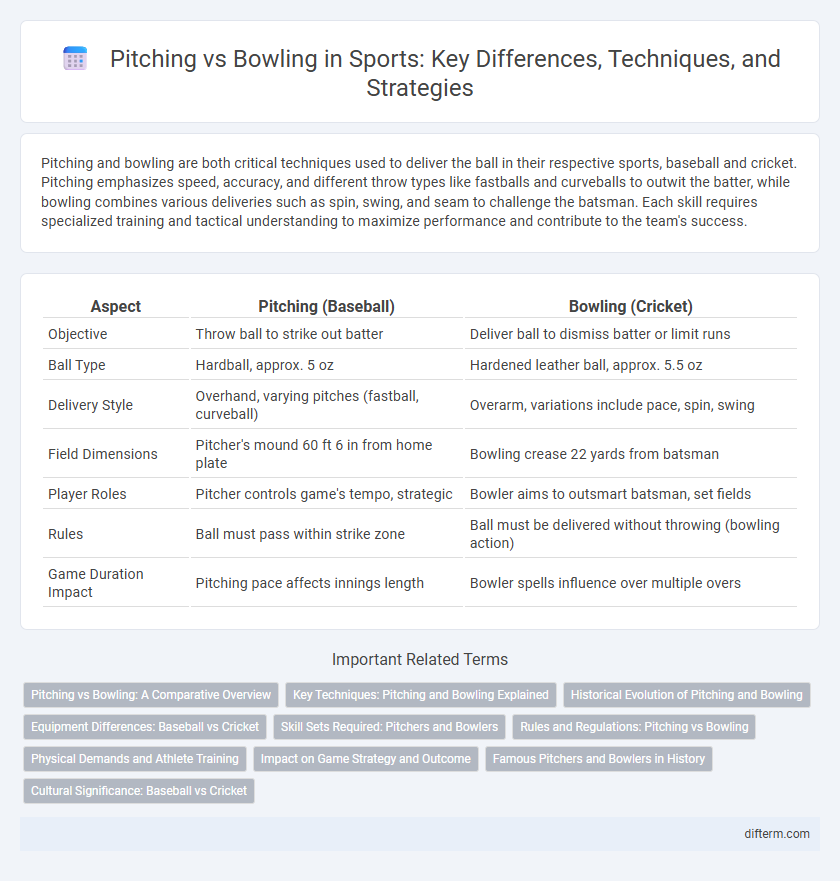Pitching and bowling are both critical techniques used to deliver the ball in their respective sports, baseball and cricket. Pitching emphasizes speed, accuracy, and different throw types like fastballs and curveballs to outwit the batter, while bowling combines various deliveries such as spin, swing, and seam to challenge the batsman. Each skill requires specialized training and tactical understanding to maximize performance and contribute to the team's success.
Table of Comparison
| Aspect | Pitching (Baseball) | Bowling (Cricket) |
|---|---|---|
| Objective | Throw ball to strike out batter | Deliver ball to dismiss batter or limit runs |
| Ball Type | Hardball, approx. 5 oz | Hardened leather ball, approx. 5.5 oz |
| Delivery Style | Overhand, varying pitches (fastball, curveball) | Overarm, variations include pace, spin, swing |
| Field Dimensions | Pitcher's mound 60 ft 6 in from home plate | Bowling crease 22 yards from batsman |
| Player Roles | Pitcher controls game's tempo, strategic | Bowler aims to outsmart batsman, set fields |
| Rules | Ball must pass within strike zone | Ball must be delivered without throwing (bowling action) |
| Game Duration Impact | Pitching pace affects innings length | Bowler spells influence over multiple overs |
Pitching vs Bowling: A Comparative Overview
Pitching and bowling are distinct techniques in sports, with pitching primarily used in baseball and softball to deliver the ball to the batter, emphasizing speed, accuracy, and varied grips to influence ball movement. Bowling, common in cricket, involves a run-up and delivering the ball overarm to the batsman, focusing on swing, seam position, and spin to outwit opponents. Both actions require precise biomechanical skills but differ significantly in rules, objectives, and playing styles.
Key Techniques: Pitching and Bowling Explained
Pitching in baseball involves a combination of grip, arm angle, and stride to deliver the ball with speed and accuracy toward the batter. Bowling in cricket requires precise wrist position, finger control, and follow-through to generate swing, spin, or seam movement aimed at deceiving the batsman. Mastery of body mechanics and release techniques critically differentiates effective pitching from skilled bowling.
Historical Evolution of Pitching and Bowling
Pitching in baseball evolved from underhand throws used in early 19th-century amateur games to the overhand deliveries standardized by the late 1800s, with innovations like the curveball introduced by pitchers such as Candy Cummings. Bowling, rooted in ancient civilizations, developed into a formalized sport in 19th-century England, later spreading to the United States, where standardized rules and equipment emerged, including the transition from nine-pin to ten-pin bowling. Both pitching and bowling have adapted over centuries, reflecting changes in competitive sports culture and advances in technique and equipment technology.
Equipment Differences: Baseball vs Cricket
Baseball pitching uses a compact, hard leather ball about 9 inches in circumference, requiring a glove for the catcher and specialized cleats for pitchers. Cricket bowling involves a slightly larger, harder ball with a cork core wrapped in leather, alongside protective gear like pads and helmets due to the ball's bounce and speed. The distinct equipment reflects the unique pitching and bowling mechanics and playing surfaces in each sport.
Skill Sets Required: Pitchers and Bowlers
Pitchers require precise arm mechanics, velocity control, and strategic pitch selection to outsmart batters. Bowlers depend on wrist flexibility, seam position, and variations in swing or spin to deceive batsmen. Both demand exceptional hand-eye coordination, timing, and mental focus to excel in their respective sports.
Rules and Regulations: Pitching vs Bowling
Pitching in baseball involves the pitcher throwing the ball towards home plate within a designated strike zone, governed by strict rules on arm motion and delivery to prevent balks and ensure fairness. Bowling, especially in cricket, requires the bowler to deliver the ball with a straight arm without bending the elbow beyond 15 degrees and from behind the popping crease, with rules in place to prevent illegal deliveries like no-balls and wides. Both sports emphasize precise legal techniques to maintain competitive integrity and safety during gameplay.
Physical Demands and Athlete Training
Pitching in baseball requires explosive rotational power and shoulder durability to sustain high-velocity throws, often demanding specialized arm care and recovery protocols. Bowling in cricket emphasizes repetitive arm motion with a focus on core strength and lower-body stability to maintain balance and accuracy throughout extended spells. Both sports necessitate athlete training programs targeting muscle endurance, flexibility, and injury prevention tailored to their unique biomechanical stresses.
Impact on Game Strategy and Outcome
Pitching in baseball strategically varies pitch speed, angle, and type to disrupt the batter's timing, directly influencing game tempo and scoring opportunities. Bowling in cricket combines pace, spin, and line precision to challenge batsmen, impacting match momentum and run containment. Both disciplines require tactical adjustments based on opponent analysis, affecting overall game strategy and outcome decisively.
Famous Pitchers and Bowlers in History
Famous pitchers like Sandy Koufax, Nolan Ryan, and Christy Mathewson revolutionized baseball with their dominant fastballs and strategic curveballs, setting records for strikeouts and no-hitters. In cricket, legendary bowlers such as Shane Warne, Muttiah Muralitharan, and Glenn McGrath shaped the sport with their skillful spin, pace, and accuracy, accumulating thousands of wickets across international formats. The contrasting techniques and historical achievements of these iconic pitchers and bowlers highlight their critical roles in shaping the legacies of baseball and cricket.
Cultural Significance: Baseball vs Cricket
Pitching in baseball and bowling in cricket both hold deep cultural significance, with baseball embodying American tradition and cricket symbolizing British colonial heritage across countries like India, Australia, and England. Baseball pitching emphasizes strategy and individual athleticism, celebrated in American cities with iconic stadiums and passionate fan bases. Cricket bowling reflects a blend of technique, endurance, and national pride, often serving as a unifying force in Commonwealth nations with historic rivalries like The Ashes between England and Australia.
pitching vs bowling Infographic

 difterm.com
difterm.com